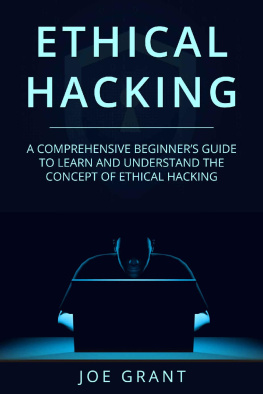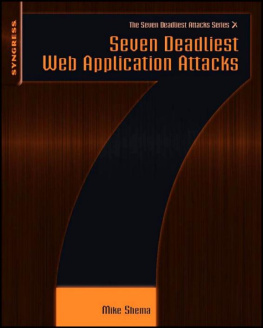Mike Shema - Hacking Web Apps: Detecting and Preventing Web Application Security Problems
Here you can read online Mike Shema - Hacking Web Apps: Detecting and Preventing Web Application Security Problems full text of the book (entire story) in english for free. Download pdf and epub, get meaning, cover and reviews about this ebook. year: 2012, publisher: Syngress, genre: Computer. Description of the work, (preface) as well as reviews are available. Best literature library LitArk.com created for fans of good reading and offers a wide selection of genres:
Romance novel
Science fiction
Adventure
Detective
Science
History
Home and family
Prose
Art
Politics
Computer
Non-fiction
Religion
Business
Children
Humor
Choose a favorite category and find really read worthwhile books. Enjoy immersion in the world of imagination, feel the emotions of the characters or learn something new for yourself, make an fascinating discovery.

- Book:Hacking Web Apps: Detecting and Preventing Web Application Security Problems
- Author:
- Publisher:Syngress
- Genre:
- Year:2012
- Rating:5 / 5
- Favourites:Add to favourites
- Your mark:
Hacking Web Apps: Detecting and Preventing Web Application Security Problems: summary, description and annotation
We offer to read an annotation, description, summary or preface (depends on what the author of the book "Hacking Web Apps: Detecting and Preventing Web Application Security Problems" wrote himself). If you haven't found the necessary information about the book — write in the comments, we will try to find it.
How can an information security professional keep up with all of the hacks, attacks, and exploits on the Web? One way is to read Hacking Web Apps. The content for this book has been selected by author Mike Shema to make sure that we are covering the most vicious attacks out there. Not only does Mike let you in on the anatomy of these attacks, but he also tells you how to get rid of these worms, trojans, and botnets and how to defend against them in the future. Countermeasures are detailed so that you can fight against similar attacks as they evolve.
Attacks featured in this book include:
. SQL Injection
. Cross Site Scripting
. Logic Attacks
. Server Misconfigurations
. Predictable Pages
. Web of Distrust
. Breaking Authentication Schemes
. HTML5 Security Breaches
. Attacks on Mobile Apps
Even if you dont develop web sites or write HTML, Hacking Web Apps can still help you learn how sites are attacked-as well as the best way to defend against these attacks. Plus, Hacking Web Apps gives you detailed steps to make the web browser - sometimes your last line of defense - more secure.
- More and more data, from finances to photos, is moving into web applications. How much can you trust that data to be accessible from a web browser anywhere and safe at the same time?
- Some of the most damaging hacks to a web site can be executed with nothing more than a web browser and a little knowledge of HTML.
- Learn about the most common threats and how to stop them, including HTML Injection, XSS, Cross Site Request Forgery, SQL Injection, Breaking Authentication Schemes, Logic Attacks, Web of Distrust, Browser Hacks and many more.
Mike Shema: author's other books
Who wrote Hacking Web Apps: Detecting and Preventing Web Application Security Problems? Find out the surname, the name of the author of the book and a list of all author's works by series.











